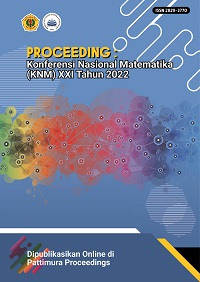Mathematical Problem-Solving Ability of Rational Personality Students
Abstract
This study aims to describe the ability of students who have personality tendencies in solving mathematical problems. This research is an exploratory study with a qualitative approach. Data was collected by giving problem solving ability tests and interviews to two subjects with rational personalities. Students' personalities were categorized based on David Keirsey's personality classification test, namely Artisan, Guardian, Idealist, and Rational. The results showed that (1) understanding the problem, in understanding the problem the subject visualized the information, this was in accordance with the characteristics of Rational who always needed something to help him in concretizing his ideas or thoughts through something, for example through pictures. (2) develop a strategy/completion plan, a) in formulating a strategy, the subject uses all the information and assumptions obtained from the problem and uses it to plan problem solving, b) in compiling a problem-solving plan, the subject does not write down the solution plan clearly, he only writes things that he deems necessary, according to his personality which has less intrapersonal ability so that they always do things as they please not based on generally agreed rules. (3) carry out the plan of completion, the subject always solves the problem according to the plan he has drawn up, this is indeed a characteristic of Rational who always does everything based on the goals he has set. (4) re-check, the subject checks the results of his work. This is in accordance with SR's personality which does not tolerate the slightest error.
Downloads
References
[2] Annizar, Anas, Maulyda, Mohammad, Khairunnisa, Gusti, AND Hijriani, Lailin. "Kemampuan Pemecahan Masalah Matematis Siswa dalam Menyelesaikan Soal PISA pada Topik Geometri" Jurnal Elemen [Online], Volume 6 Number 1 (31 Januari 2020)
[3] Gumilang, M. R., Wahyudi, & Indarini, E. Pengembangan Media Komik dengan Model Problem Posing untuk Meningkatkan Kemampuan Pemecahan Masalah Matematika. Journal of Medives : Journal Of Mathematics Education IKIP Veteran Semarang, 3(2), 185-196. (22 Juli 2019)
[4] Jumrah dan Sri Anggriani. Peningkatan Aktivitas dan Hasil Belajar Matematika Melalui Penerapan Metode Problem Solving. Al-Irsyad Journal of Mathematics Education Vol 1 No 1 (16 Januari 2022)
[5] Jumrah, Sri Anggriani, dan St. Hardiyanti. “Pengaruh Self-Confidence Terhadap Hasil Belajar Matematika Siswa”. Al-Irsyad Journal of Mathematics Education 1, no. 2 (Juli 30, 2022): 88–94.
[6] Keirsey, David dan Bates, Marilyn. Please Understand Me. (Promotheus Nemesis Book Company, California, 1985)
[7] Keirsey, David. Please Understand Me II Temperament, Character, and Intelligence. (Promotheus Nemesis Book Company, California, 1985), 1998.
[8] Keirsey, David. About 4 Temperaments. (online), http://www.keirsey.com, 2019.
[9] Maulyda, Mohammad Archi. Paradigma Pembelajaran Matematika Berbasis NCTM. (CV IRDH, Malang, 2019)
[10] Santrock, John W. Psikologi Pendidikan. (Kencana, Jakarta, 2004)
[11] Setyadi, I. M. A., Sudiarta, I. G. P., & Mertasari, N. M. S., The effect of predict-observe-explain (POE) learning model using open-ended problem (OEP) towards students’ mathematical problem-solving skill. Jurnal Pendidikan dan Pengajaran, 52(3), 133–144. (7 Januari 2020)
[12] Widodo, Sri Adi. “Analisis Kesalahan Dalam Pemecahan Masalah Divergensi Tipe Membuktikan Pada Mahasiswa Matematika”. Jurnal Pendidikan dan Pengajaran 46, no. 2 Juli (July 1, 2013). Accessed October 11, 2022.
Copyright (c) 2023 Pattimura Proceeding: Conference of Science and Technology

This work is licensed under a Creative Commons Attribution-NonCommercial-ShareAlike 4.0 International License.












